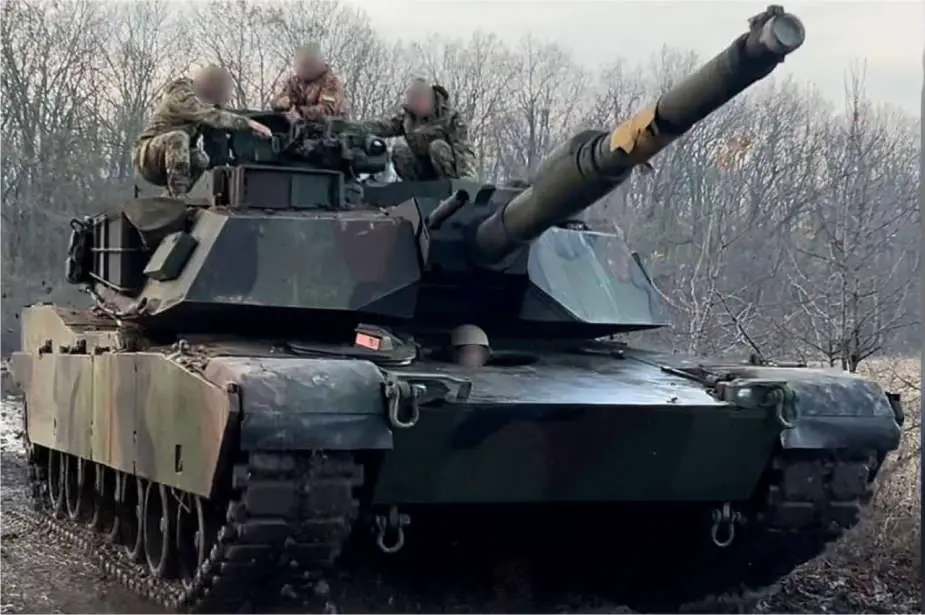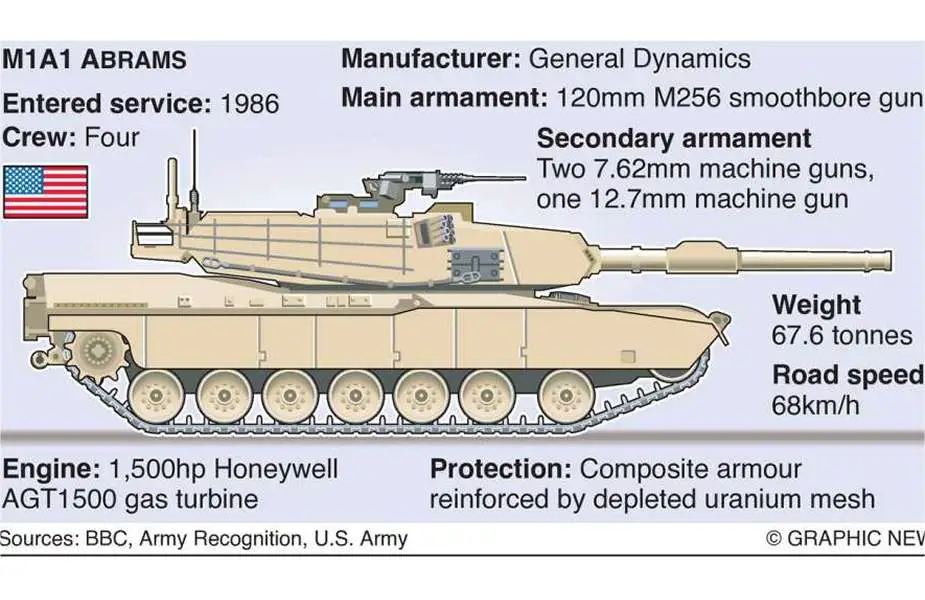- Army
- Conflicts in the world
- Israel - Iran conflict 2025
- Pakistan - India Conflict 2025
- Russia Ukraine War 2022
- Libya conflict day by day
- HAMAS - Israel War 2023
- Operation Serval in Mali French Army
- Sangaris operation Central African Republic
- Sangaris opération militaire République Centreafrique
- Ukraine - Russia conflict
- Syria conflict news
- Defence & Security Industry Technology
- Armies in the world
- Analysis Defense and Security Industry
- Conflicts in the world
- Navy
- Air
Military Equipment Russian-Ukrainian Conflict - Episode 3: US M1A1 Abrams Main Battle Tank
Army Recognition presents a new series on the various vehicles and equipment used in the Russian-Ukrainian conflict, and here we are already at the third episode. The focus turns to the formidable M1A1 Abrams tank. This episode is dedicated to unveiling the capabilities, history, and tactical role of the M1A1 Abrams within the conflict, highlighting why this piece of military equipment remains a pivotal element in the chess game of contemporary warfare, underlining its status as a symbol of armored resilience and striking power. We will also compare this US tank with some of its opponents such as the T-90M and the T-72.
Follow Army Recognition on Google News at this link

Footage of a US M1A1 Abrams Main Battle Tank operated by Ukrainian forces. (Picture source: Open Source Information)
The M1A1 Abrams tanks arrived in Ukraine in September 2023, with their arrival announced by President Zelensky on September 25. The United States had promised to supply 31 M1A1 Abrams tanks to Ukraine, part of the over $43 billion in security assistance promised by the United States over the last 18 months. These tanks come from the reserves of the U.S. Army and were chosen for their rapid availability compared to the newer M1A2 versions. The supplied M1A1s have undergone significant upgrades, particularly in terms of armor and electronics, bringing them closer to the level of the M1A2s. All 31 promised Abrams tanks were delivered to Ukraine by October 16, 2023, and the Ukrainian troops trained in their use in Germany have also returned to Ukraine with ammunition and spare parts for the tanks.
The M1A1 Abrams is a main battle tank developed by the United States, known for its combination of firepower, protection, and mobility. Its main armament consists of a 120 mm cannon, complemented by a 7.62 mm coaxial machine gun, a 7.62 mm top turret machine gun, and a 12.7 mm anti-aircraft machine gun. This tank uses advanced composite armor, incorporating depleted uranium, known as Chobham armor, offering exceptional protection against anti-tank projectiles.
The M1A1 Abrams is in service in several countries, including Australia, Egypt, Iraq, Poland, Saudi Arabia, and most recently, Ukraine, highlighting its attractiveness and reliability on the international market. With a weight of 62 tons, it is capable of reaching a maximum speed of 68 km/h thanks to its design and engine.
This tank is also equipped with a wide range of accessories intended to improve its operational capabilities and crew survival. It is equipped with a sophisticated fire control system, a laser rangefinder, night vision, and thermal imaging, as well as an NBC (nuclear, biological, chemical) protection system, heating, and an automatic fire extinguishing system. These types of equipment allow the M1A1 Abrams to operate in various environments and conditions, day and night, and to withstand potential attacks with NBC agents.
The crew of the M1A1 Abrams consists of four members: the commander, gunner, loader, and driver, each playing a crucial role in the operation and maintenance of the tank. The dimensions of the M1A1 are as follows: a length of 9.83 m, a width of 3.65 m, and a height of 2.89 m. Its operational range is 426 km.
In comparison, the American M1A1 Abrams and the Russian T-90M are two of the most advanced main battle tanks in the world, each with its strengths. The M1A1 Abrams are known for their exceptional mobility, powered by a Honeywell AGT 1500 gas turbine engine and an Allison X-1100-3B automatic transmission, allowing top speeds of 72 km/h on roads and 48 km/h off-road.
The Russian T-90M, on the other hand, is a modern upgrade of the T-90 tank, designed to improve protection, firepower, and mobility. It is known for its reinforced armor, improved fire control system, and the use of modern munitions. The T-90M also incorporates advanced technologies of camouflage and protection against anti-tank-guided weapons.
The T-90M, a modernized version of the T-90 main battle tank, has a key advantage in its capability to fire anti-tank guided missiles (ATGMs) such as the Refleks (NATO code AT-11 Sniper-B), directly from its main 125 mm smoothbore gun. This capability significantly enhances its combat flexibility, allowing it to engage targets at ranges up to 5,000 meters with a high probability of a first-round hit. The Refleks missile, with its laser beam riding guidance system, can penetrate up to 900 mm of armor, making it a formidable weapon against heavily armored targets.
On the other hand, the M1A1 Abrams main battle tank, although not equipped to fire missiles, utilizes advanced munitions such as armor-piercing fin-stabilized discarding sabot (APFSDS) rounds made from depleted uranium (DU). These rounds offer significant penetrative capability against armored threats. It's worth noting, however, that the DU rounds provided to the M1A1 Abrams have not been supplied to Ukraine, highlighting operational and export control considerations. The Abrams relies on its powerful 120mm smoothbore gun, advanced fire control systems, and superior mobility to engage and defeat enemy armor effectively.
Both tanks present impressive capabilities on the battlefield, but their real combat performance can be influenced by many factors, including logistical support, crew training, and the tactics employed, viewed from this angle the Russian tanks have an advantage compared to the M1A1 which is operated by Ukrainians who do not have the same level of training. The advanced technology and armament of the Abrams make it extremely competitive against the T-90M, especially in terms of mobility and survivability.
Although the Abrams are considered among the most powerful tanks currently in operation, surpassing in capabilities of the majority of tanks used by the Russian army, their effective use on the Ukrainian ground could face specific challenges due to the current realities of the battlefield. This did not prevent the destruction and damage of 4 of the 31 M1A1 Abrams sent to Ukraine.
During the Gulf War, especially in engagements like the Battle of 73 Easting, the M1A1 Abrams tanks demonstrated significant superiority over the Iraqi T-72s, primarily due to their advanced technology, firepower, armor, and mobility. The Abrams' 120mm gun, advanced fire control systems, and composite armor, including layers of depleted uranium, allowed it to engage and destroy T-72s at long ranges with high accuracy, often before the T-72s could effectively respond. The Abrams' performance highlighted the technological and tactical disparities between the Western and Soviet-era tank designs, emphasizing the importance of technological superiority in modern armored warfare.
Tank versus tank combat is limited in this conflict, and dense minefields have hindered the advances of heavy armor. Thus, the impact of the Abrams could be more tactical than strategic. These tanks could be used to provide fire support during infantry assaults, helping to clear enemy positions and overcome obstacles such as minefields, while facing threats such as drones, anti-tank missiles, and artillery. The Ukrainian approach so far has been to prioritize infantry to break through Russian defenses, with tanks and artillery following to support the assault.
However, even though the arrival of the M1A1 Abrams tanks among the Ukrainian forces is not a "Game-Changer" (for that, a much larger number of tanks would be needed), they are nonetheless more than welcome compared to what the Ukrainians had. Before the arrival of the M1A1 Abrams tanks, the Ukrainian forces primarily used tanks inherited from the Soviet era. Compared to these tanks, the M1A1 Abrams offers a significant improvement in terms of protection, mobility, night vision capabilities, firepower, and range. This represents a significant advantage for Ukraine in the current conflict, as the M1A1 Abrams has proven its effectiveness in various military operations since its service entry in 1980.
 M1A1 Abrams Main Battle Tank. (Picture Source: Graphic News)
M1A1 Abrams Main Battle Tank. (Picture Source: Graphic News)


























